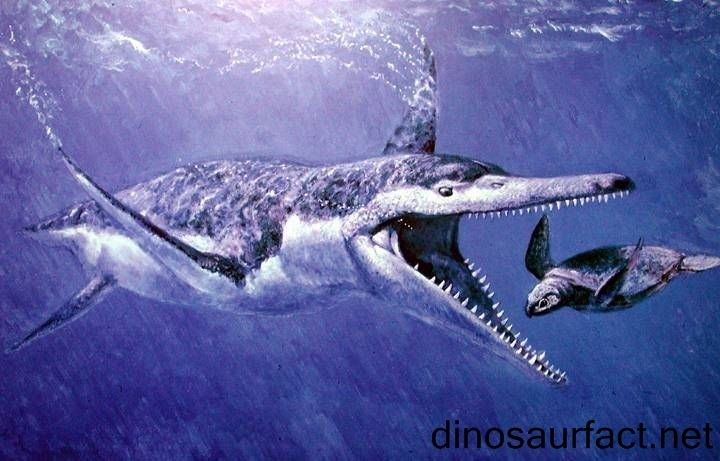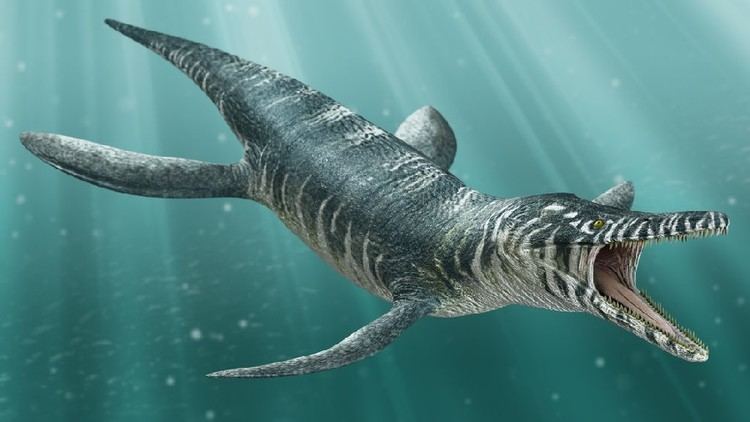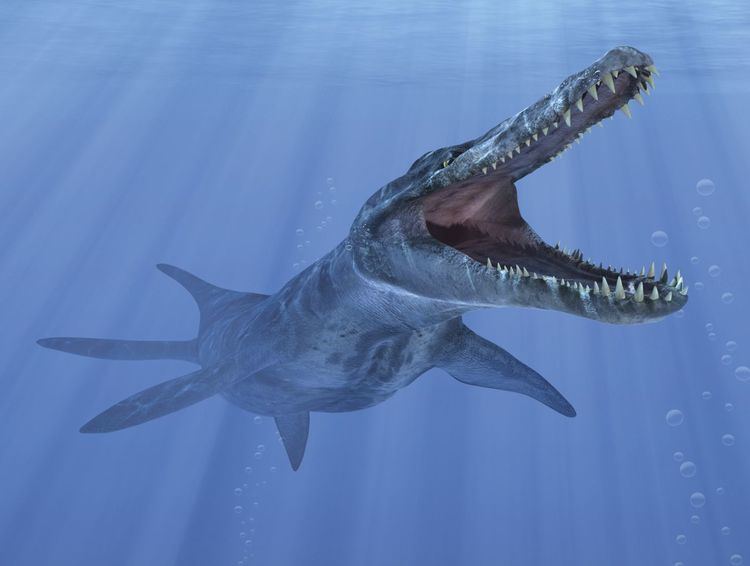Scientific name Kronosaurus | Subfamily †Brachaucheninae | |
 | ||
Similar | ||
Kronosaurus vs mosasaurus who would win s2
Kronosaurus (/ˌKrɒNOʊˈSɔːrəs/ KRON-o-SAWR-əs; meaning "lizard of Kronos") is an extinct genus of short-necked pliosaur. With an estimated length of 9-10.5 m, it was among the largest pliosaurs, and is named after the leader of the Greek Titans, Cronus. It lived in the Early Cretaceous Period (Aptian-Albian). fossil material has been recovered from Queensland in Australia, and Colombia, and assigned to two species.
Contents
- Kronosaurus vs mosasaurus who would win s2
- Kronosaurus jurassic world lagoon series ep 3 hd
- Description
- Size issues
- Teeth
- Discovery and species
- Classification
- Paleobiology
- Palaeoecology
- References

Kronosaurus jurassic world lagoon series ep 3 hd
Description

Like other pliosaurs, Kronosaurus was a marine reptile. It had an elongated head, a short neck, a stiff body propelled by four flippers, and a relatively short tail. The posterior flippers were larger than the anterior. Kronosaurus was carnivorous, and had many long, sharp, conical teeth. A feature of the genus Kronosaurus is the first three maxillary teeth are enlarged to fangs. Current estimates put Kronosaurus at around 9–10.5 meters (30–34 feet) in length. In 2009, K. queenslandicus was estimated to weigh up to 11,000 kilograms (11 metric tons).

All Sauropterygians had a modified pectoral girdle that supported a powerful swimming stroke. Kronosaurus and other plesiosaurs/pliosaurs had a similarly adapted pelvic girdle, allowing them to push hard against the water with all four flippers. Between its two limb girdles was a massive mesh of gastralia (belly ribs) that provided additional strength and support. The strength of the limb girdles, combined with evidence of large, powerful swimming muscles, indicates that Kronosaurus was likely a fast, active swimmer.

Kronosaurus queenslandicus has four pairs of premaxillary teeth. The first three pairs of its maxillary teeth are large caniniform teeth, and in its lower jaw there are also three pairs of large caniniform teeth which are located immediately in front of the three maxillary caniniforms when the mouth is closed. Two pairs of the lower jaw caniniforms occlude between the last pair of premaxillary teeth and first pair of maxillary teeth in a diastema (gap in the tooth row). The enlargement of these two pairs of lower jaw teeth in K. queenslandicus may be related to the absence of a fifth pair of premaxillary teeth, which are present in a number of other pliosaurs.

Oliver Hampe described Kronosaurus boyacensis as having five pairs of premaxillary teeth. Colin Richard McHenry has said that the premaxillary tooth count of K. boyacensis requires confirmation and that if its premaxillary tooth count is confirmed to be five, it may be appropriate to place K. boyacensis into a different genus to K. queenslandicus. In addition to apparently having a different premaxillary tooth count, K. boyacensis differs from K. queenslandicus in postcranial features and possibly tooth ornamentation.
Size issues

Body-length estimates, largely based on the 1959 Harvard reconstruction, had previously put the total length of Kronosaurus at 12.8 meters (42 feet). However, more recent studies, comparing fossil specimens of Kronosaurus to other pliosaurs suggests that the Harvard reconstruction may have included too many vertebrae, exaggerating the previous estimate, with the true length probably only 9–10.5 meters (30–34 feet).
Teeth

Kronosaurus teeth exceed 7 cm in length (the largest up to 30 cm long with 12 cm crowns). However, they lack carinae (cutting edges) and the distinct trihedral (three facets) of Pliosaurus and Liopleurodon teeth. The combination of large size, conical shape and lack of cutting edges allows for easy identification of Kronosaurus teeth in Cretaceous deposits from Australia.
Discovery and species
In 1899, Andrew Crombie of Hughenden discovered a "scrap of bone" containing six conical teeth, and gave this fragmentary fossil to the Queensland Museum. Twenty-five years later, then-director Heber Longman formally described the specimen as the holotype of a new species: Kronosaurus queenslandicus. More Kronosaurus material, including a partial skull, was discovered in 1929, in the same location as Crombie's original find.
While touring Australia in 1932, a fossil-hunting expedition from Harvard University led by William E. Schevill was told of some interesting rocks on some property near Hughenden. The rocks were limestone nodules containing the most complete skeleton of Kronosaurus ever discovered. After dynamiting the nodules out of the ground (and into smaller pieces), Scheville had them shipped back to Harvard for examination and preparation. The skull—which matched the holotype jaw fragment of K. queenslandicus—was prepared right away, but time and budget constraints put off restoration of the nearly complete skeleton for 20 years. The restored and mounted skeleton was displayed at Harvard in 1959.
In 1977, a Colombian peasant farmer from Moniquirá turned up an enormous stone while tilling his field, which he later recognized as a possible fossil. Excavation revealed a nearly complete Kronosaurus skeleton, one of the best preserved fossils to come from Colombia. Oliver Hampe formally described the specimen in 1992, assigning it to a second species, K. boyacensis.
The people of Villa de Leyva built a museum, El Fósil, around the spot where the skeleton was excavated, and the K. boyacensis skeleton is on display there.
Classification
The cladogram below follows a 2011 analysis by paleontologists Hilary F. Ketchum and Roger B. J. Benson, and reduced to genera only.
Paleobiology
Fossil stomach contents from Northern Queensland show that Kronosaurus preyed on turtles and plesiosaurs. Fossil remains of giant squid have been found in the same area as Kronosaurus; it may have fed on them, but no direct evidence for this exists.
Large, round bite-marks have been found on the skull of an Albian-age Australian elasmosaurid (Eromangasaurus) that could be from a Kronosaurus attack.
Palaeoecology
Kronosaurus is known from Australia and Colombia. Both areas were covered by shallow inland seas when Kronosaurus inhabited them.
